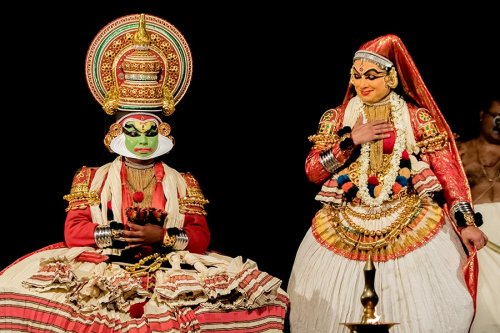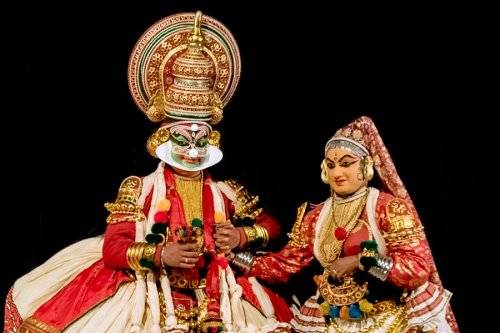
|   |

|   |
The triumph of Narakasura Text & pics: Hareesh N. Nampoothiri e-mail: newn.haree@gmail.com September 24, 2015 ‘Narakasuravadham’ Kathakali play by Karthika Thirunal Rama Varma narrates the story of the demon Narakasura and how he ends up getting killed by Lord Krishna. As it will take a whole night to present the story in full, it makes sense to present selected scenes showcasing the best parts of the play. The presentation arranged by Drisyavedi here in Thiruvananthapuram on 15th of September, as part of the twentieth ‘Keralarangakalolsavam’ also took this liberty and presented the edited version. The scenes presented were the one between Jayanthan and Lalitha, Narakasura and his wife and finally Narakasura’s winning fight with the gods seizing the heavens. Though the full story is about slaying of Narakasura, omitting the final scenes made it ‘Narakasuravijayam’, sort of celebrating the victory of the demon.  Kalamandalam Sudeep as Jayanthan and Kalamandalam Vijayakumar as Lalitha A demoness named Nakrathundi transformed into a beautiful damsel (pictured as Lalitha), tries to seduce Jayanthan, the son of Indra. But Jayanthan succeeds in seeing through her disguise and sends her away after deforming her by cutting her nose, ears and breasts. While this is the story of the first half in a nutshell, what makes it superlative is the way the scene is imagined in Kathakali format. It is all up to the actor playing the role of Lalitha and Kalamandalam Vijayakumar did it admirably well winning the heart of everyone around except that of Jayanthan, who is forced to stick to the storyline! Right from the entry, Vijayakumar was well in tune with the character and it only got better as the play progressed. The sthayi remained Sringara and the shades of ignoble intentions flashed as Jayanthan took a hard stand rejecting her pleas. Kalamandalam Sudeep in the role of Jayanthan also did his part fairly well to make his character lively. He also came in as Indra towards the end of the play. The scene is not just about possibilities for the actors, but has enough in it for the singers too to excel. “Vrithavairi Nandana...,” the slow tempo padam in raga Neelambari and “Enangasamavadana...” in Thodi were evocative as Kalamandalam Babu Namboothiri efficaciously rendered the lines. A delightful change was when “Manushanariyumalla...” rendered in Kapi, a deviation from the originally prescribed Neelambari (or a handful other ragas the singers used to try these days). Kalamandalam Vishnu was the co-singer. While the first part focused on Nakrathundi, an orderly of Narakasura, the latter brings Narakasura to occupy the center stage. Kalamandalam Shanmukhadas came in as the demon king. Shanmukhadas is an actor who has proved his mettle in handling lead roles irrespective of the category they fall into. Having said this, his presentation of Narakasura fell short of expectations here. The elaborated thiranottam evinced satisfying but failed to impress in the slow tempo padam that followed. The expressions, be it sringara or veera, remained flat most of the time and the footwork lacked finesse making the highly embellished ‘Keki’ (elaborate display of the mannerisms of a peacock), thoughtful descriptions of the sound that gets louder and louder (sabdavarnana), preparations for the war (padappurappadu) etc. dull and less captivating. Time was also a constraint towards the end, but knowing the caliber of the actor, one can only say that it was not his day. Kalamandalam Jishnu Ravi appeared as Narakasurapathni.  Kalamandalam Shanmukhadas as Narakasura and Kalamandalam Jishnu Ravi as Narakasurapathni The percussion was handled by a team of youngsters - Kalamandalam Venumohan and Kalamandalam Sreevin on the chenda and Kalamandalam Vineeth and RLV Jithin on the maddalam. Accompanying the character of Narakasura requires a lot of caliber and the quartet pulled out a decent job, well utilizing the opportunity given to them. Artists and members from the Margi troupe were in charge of the costumes and facial make-up. Hareesh N. Nampoothiri is a visual design consultant by profession, an art lover by obsession and a photographer who specializes in dance photography. He writes regularly on classical dance performances and films for various web / print media. He is also an author of three books; director of ‘Thouryathrikam,’ a documentary feature on Kathakali and the founder of NEWNMEDIA™, a firm providing digital design solutions. |